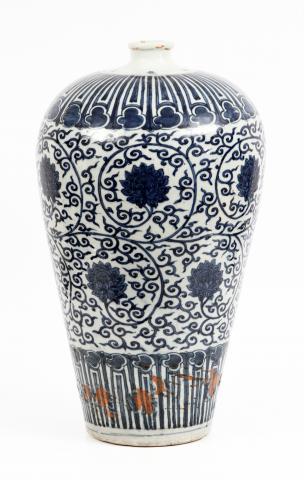Vaso Meiping
Porcelana branca vidrada decorada a azul-cobalto, Jingdezhen
China, dinastia Ming, fornos de Jingdzhen
Marca e período Wanli (1572-1620)
Alt.: 47,0 cm
Figurou em: “A Cidade Global, Lisboa no Renascimento”, M. N. Arte Antiga, Lisboa 2017; (catálogo pág. 147)
Meiping Vase
Cobalt-blue glazed white porcelain
China, Ming dynasty, Jingdzhen kilns
Marked for Wanli reign (1572-1620)
Height: 47,0 cm
Exhibited in: “A Cidade Global, Lisboa no Renascimento”, M. N. Arte Antiga, Lisboa 2017; (catálogo pág. 147)
Jarra alta, bojuda, de gargalo estreito, em porcelana branca e com rica decoração a azul-cobalto sob vidrado, fabricada no período Wanli e com marcas do período.
Corpo está profusamente decorado com flores de Lótus e enrolamentos vegetalistas, terminando no ombro e junto à base com uma curiosa interpretação de “Painéis de Lótus”, rematados por um friso com uma sequência de trifólios estilizados.
Marca Wanli a seis caracteres em círculo a azul, envolvendo o gargalo, com a inscrição Wanli nian hao – feito no período Wanli da Grande Dinastia Ming.
Defeito de cozedura na base e pequeno restauro no bocal.
Meiping é um vaso destinado a conter galhos de ameixeira, flor muito apreciada na cultura chinesa uma vez que marca o fim do inverno frio e rigoroso. O aparecimento da flor anuncia o aproximar da primavera e é responsável por um sentimento de alegria e emoção, que invade o povo.
Este tipo de meiping era cuidadosamente fabricado nas oficinas reais, durante o reinado de Wanli, para uso do palácio e da corte. São extremamente raros os meiping com esta dimensão: foram encontrados três pares, com o mesmo tipo de decoração e dimensões idênticas no mausoléu de Dingling - local onde o Emperador Wanli e as suas duas mulheres Wang Xijie e Dowager Xiaojing foram enterrados - durante as escavações feitas de 1956 a 1958 .
A porcelana Ming foi principalmente decorada com motivos evocativos da efemeridade da vida, como por exemplo, flores e plantas em movimentos rápidos, quase que instantâneos. O azul e branco predominou durante cinco séculos na porcelana chinesa (séculos XIV ao XVIII). A idade de ouro é reinado de Xuande (1426-1435), época em que se produziram tigelas, taças, pratos, garrafas de peregrino, meiping, aquários e garrafas, decorados com peixes, aves, árvores, plantas aquáticas e paisagens.
--
White, Wanli reign marked, tall wide-body porcelain vase of narrow neck, decorated in rich cobalt-blue slip under the glaze. The body, profusely decorated with Lotus flowers and foliage scrolls, ends, towards the shoulder and base, in a curious interpretation of “Lotus panels”, encircled by a frieze of stylized trefoils.
Six character Wanli mark within a blue ring encircling the neck, meaning Wanli nian hao – made in the Wanli reign of the Great Ming Dynasty.
Firing faults around the base and small restoration to the lip.
Meiping are vases destined to hold flowering plum tree branches, most appreciated in Chinese culture as they indicate the end of cold and rigorous winters. The flowering trees, announcing the arrival of spring, are responsible for the feeling of happiness and emotion that suddenly invades the people.
This particular type of meiping vase, produced in the royal potteries throughout the Wanli reign, was destined to be used in the Imperial palace or by courtiers. Meiping as large as this are extremely rare. Three pairs, with the same type of decoration and identical dimensions, were unearthed from the Dingling Mausoleum – the tomb of emperor Wanli and of his two wives Wang Xijie e Dowager Xiaojing – during the archaeological excavation seasons of 1956 to 1958 .
Ming porcelain was generally decorated with motifs evoking the ephemeral nature of life, such as fast, almost instantaneous brushstroke flowers and plants. The blue and white that predominated for five centuries of Chinese porcelain production, from the 14th to the 18th centuries, will reach its golden age during the Xuande reign (1426-1435). Large numbers of bowls, plates, pilgrim bottles, meiping, fishbowls and bottles were produced throughout this reign in a variety of decorative compositions that included fish, birds, trees aquatic plants and landscapes.
- Arte Colonial e Oriental
- Artes Decorativas
- Porcelanas

